PONTIAC FIERO 1988 Service Repair Manual
Manufacturer: PONTIAC, Model Year: 1988, Model line: FIERO, Model: PONTIAC FIERO 1988Pages: 1825, PDF Size: 99.44 MB
Page 711 of 1825
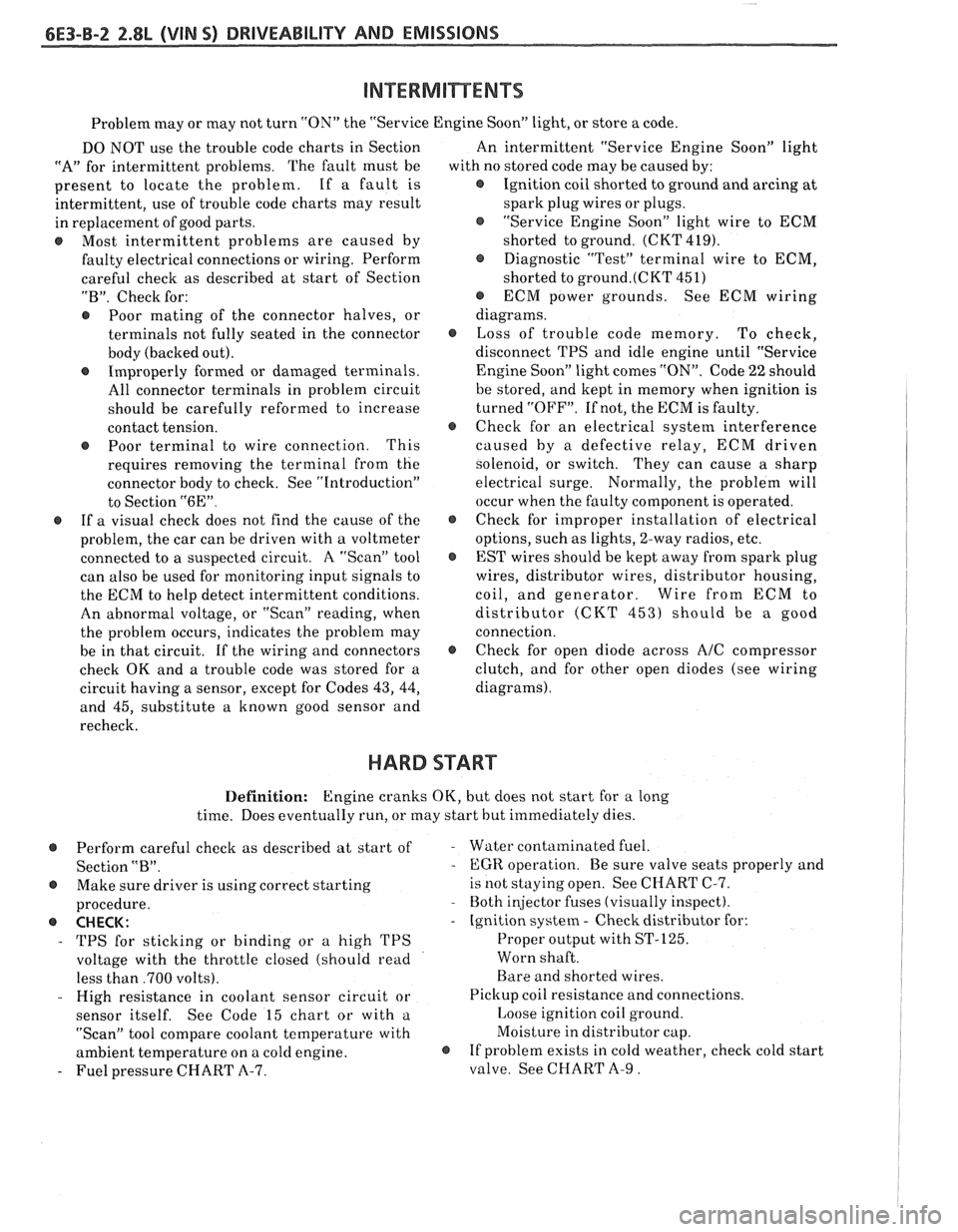
6E3-B-2 2.8L (VIN 5) DRIVEABILITY AND EMISSIONS
Problem may or may not turn "ON" the "Service Engine SoonJ' light, or store a code.
DO NOT use the trouble code charts in Section
"A" for intermittent problems. The fault must be
present to locate the problem. If a fault is
intermittent, use of trouble code charts may result
in replacement of good parts.
@ Most intermittent problems are caused by
faulty electrical connections or wiring. Perform
careful check as described at start of Section
"B". Check for:
@ Poor mating of the connector halves, or
terminals not fully seated in the connector
body (backed out).
@ Improperly formed or damaged terminals.
All connector terminals in problem circuit
should be carefully reformed to increase
contact tension.
@ Poor terminal to wire connection. This
requires removing the terminal from the
connector body to check. See "Introduction"
to Section
"6E".
@ If a visual check does not find the cause of the
problem, the car can be driven with a voltmeter
connected to a suspected circuit. A "Scan" tool
can also be used for monitoring input signals to
the ECM to help detect intermittent conditions.
An abnormal voltage, or "Scan" reading, when
the problem occurs, indicates the problem may
be in that circuit. If the wiring and connectors
check OK and a trouble code was stored for a
circuit having a sensor, except for Codes
43, 44,
and 45, substitute a known good sensor and
recheck. An
intermittent "Service Engine Soon" light
with no stored code may be caused by:
@ Ignition coil shorted to ground and arcing at
spark plug wires or plugs.
@ "Service Engine Soon" light wire to ECM
shorted to ground. (CKT 419).
@ Diagnostic "Test" terminal wire to ECM,
shorted to
ground.(CKT 451)
@ ECM power grounds. See ECM wiring
diagrams.
@ Loss of trouble code memory. To check,
disconnect TPS and idle engine until "Service
Engine Soon" light comes "ON". Code
22 should
be stored, and kept in memory when ignition is
turned "OFF". If not, the ECM is faulty.
@ Check for an electrical system interference
caused by a defective relay, ECM driven
solenoid, or switch. They can cause
a sharp
electrical surge. Normally, the problem will
occur when the faulty component is operated.
@ Check for improper installation of electrical
options, such as lights, 2-way radios, etc.
@ EST wires should be kept away from spark plug
wires, distributor wires, distributor housing,
coil, and generator. Wire from ECM to
distributor (CKT
453) should be a good
connection.
@ Check for open diode across A/C compressor
clutch, and for other open diodes (see wiring
diagrams).
HARD START
Definition: Engine cranks OK, but does not start for a long
time. Does eventually run, or may start hut immediately dies.
@ Perform careful check as described at start of -
Section "B".
@ Make sure driver is using correct starting
procedure.
@ CHECK:
- TPS for sticking or binding or a high TPS
voltage with the throttle closed (should read
less than
,700 volts).
- High resistance in coolant sensor circuit or
sensor itself. See Code 15 chart or with
a.
"Scan" tool compare coolant temperature with
ambient temperature on
a cold engine. 8
- Fuel pressure CHART A-7. Water contaminated
fuel.
EGR operation. Be sure valve seats properly and
is not staying open. See CHART C-7.
Both injector fuses (visually inspect).
Ignition system
- Check distributor for:
Proper output with ST-125.
Worn shaft.
Bare and shorted wires.
Pickup coil resistance and connections.
Loose ignition coil ground.
Moisture in distributor cap.
If problem exists in cold weather, check cold start
valve. See CHART A-9.
Page 712 of 1825
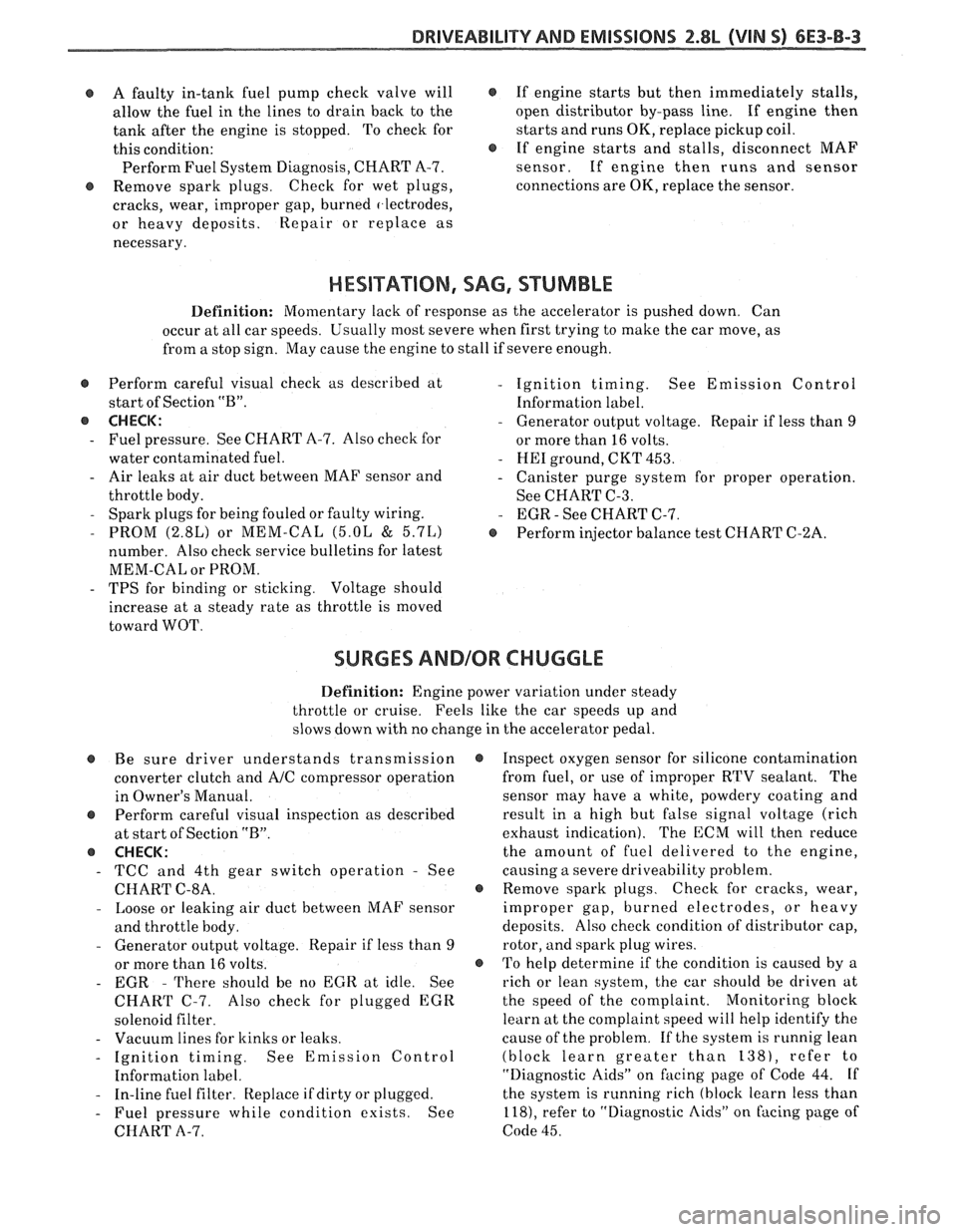
DRIVEABILITY AND EMISSIONS 2.8L (VIN S) 6E3-B-3
e A faulty in-tank fuel pump check valve will @ If engine starts but then immediately stalls,
allow the fuel in the lines to drain back to the open
distributor by-pass line. If engine then
tank after the engine is stopped. To check for starts
and runs OK, replace pickup coil.
this condition:
@ If engine starts and stalls, disconnect MAF
Perform Fuel System Diagnosis, CHART A-7. sensor. If engine then runs and sensor
@ Remove spark plugs. Check for wet plugs, connections are OK, replace the sensor.
cracks, wear, improper gap, burned
f lectrodes,
or heavy deposits. Repair or replace as
necessary.
HESITATION, SAG, STUMBLE
Definition: Momentary lack of response as the accelerator is pushed down. Can
occur at all car speeds.
Usually most severe when first trying to make the car move, as
from a stop sign. May cause the engine to stall if severe enough.
Perform careful visual check as described at
start of Section
"B".
a CHECK:
- Fuel pressure. See CHART A-7. Also check for
water contaminated fuel.
- Air leaks at air duct between MAF sensor and
throttle body.
- Spark plugs for being fouled or faulty wiring.
- PROM (2.8L) or MEM-CAL (5.OL & 5.7L)
number. Also check service bulletins for latest
MEM-CAL or PROM.
- TPS for binding or sticking. Voltage should
increase at a steady rate as throttle is moved
toward WOT.
- Ignition timing. See Emission Control
Information label.
- Generator output voltage. Repair if less than 9
or more than 16 volts.
- HE1 ground, CKT 453.
- Canister purge system for proper operation.
See CHART C-3.
- EGR - See CHART C-7.
@ Perform injector balance test CHART C-2A.
SURGES AND/OR CHUGGLE
Definition: Engine power variation under steady
throttle or cruise. Feels like the car speeds up and
slows down with no change in the accelerator pedal.
Be sure driver understands transmission
converter clutch and
A/C compressor operation
in Owner's Manual.
e Perform careful visual inspection as described
at start of Section
"B".
CHECK:
- TCC and 4th gear switch operation - See
CHART C-8A.
- Loose or leaking air duct between MAF sensor
and throttle body.
- Generator output voltage. Repair if less than 9
or more than 16 volts.
- EGR - There should be no EGR at idle. See
CHART C-7. Also check for plugged EGR
solenoid filter.
- Vacuum lines for kinks or leaks.
- Ignition timing. See Emission Control
Information label.
- In-line fuel filter. Replace ifdirty or plugged.
- Fuel pressure while condition exists. See
CHART A-7.
@ Inspect oxygen sensor for silicone contamination
from fuel, or use of improper RTV sealant. The
sensor may have a white, powdery coating and
result in a high but false signal voltage (rich
exhaust indication). The ECM will then reduce
the amount of fuel delivered to the engine,
causing a severe driveability problem.
@ Remove spark plugs. Check for cracks, wear,
improper gap, burned electrodes, or heavy
deposits. Also check condition of distributor cap,
rotor, and spark plug wires.
@ To help determine if the condition is caused by a
rich or lean system, the car should be driven at
the speed of the complaint. Monitoring block
learn at the complaint speed will help identify the
cause of the problem. If the system is runnig lean
(block learn greater than
138), refer to
"Diagnostic Aids" on
facing page of Code 44. If
the system is running rich (block learn less than
118), refer to "Diagnostic Aids" on facing page of
Code 45.
Page 713 of 1825
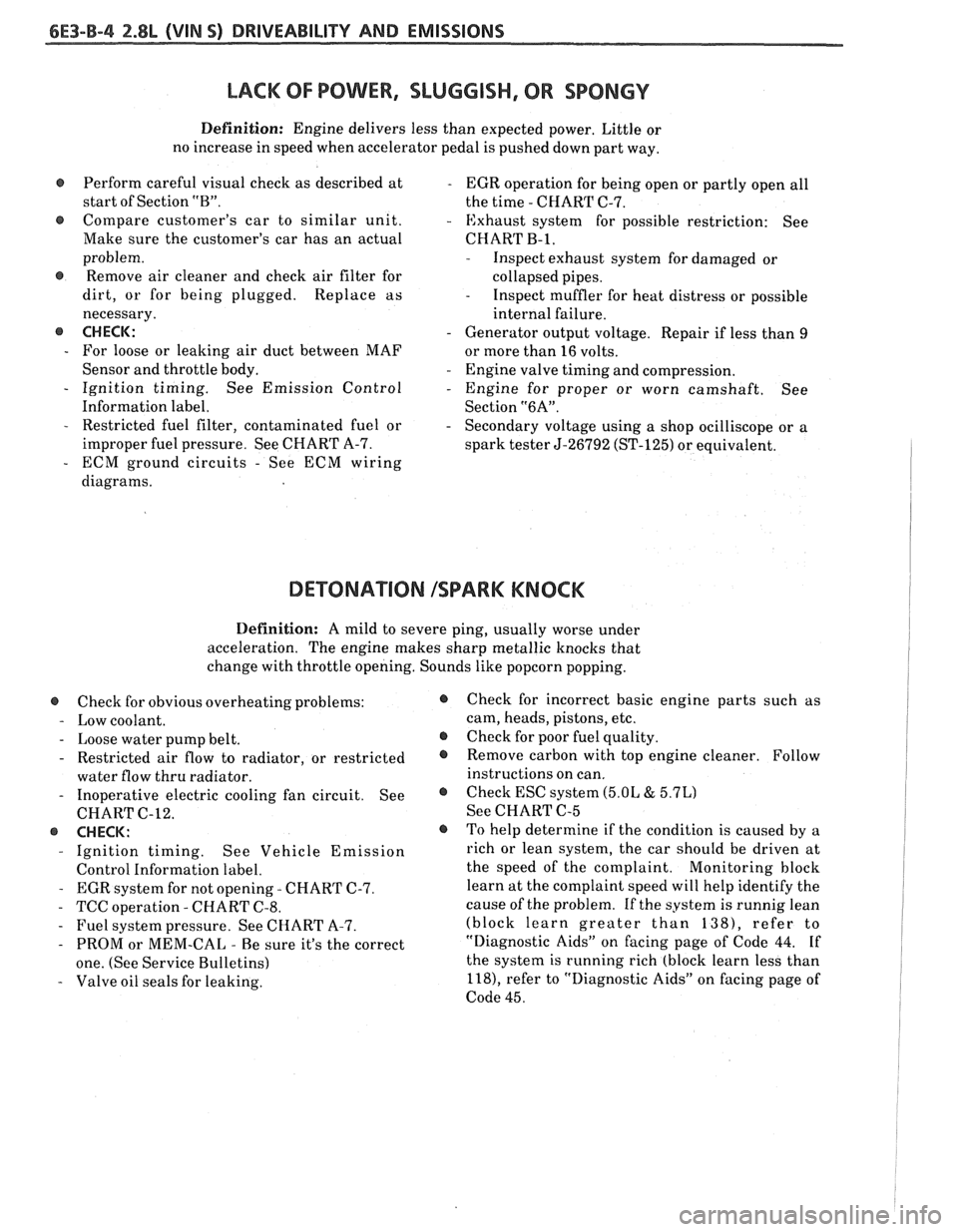
&E3-B-4 %.8L (VIN S) DRIVEABILITY AND EMISSIONS
LACK OF POWER, SLUGGISH, OR SPONGY
Definition: Engine delivers less than expected power. Little or
no increase in speed when accelerator pedal is pushed down part way.
Perform careful visual check as described at
- EGR operation for being open or partly open all
start of Section
"B". the time - CHART C-7.
e Compare customer's car to similar unit. - Exhaust system for possible restriction: See
Make sure the customer's car has an actual CHART
B-1,
problem.
@ Remove air cleaner and check air filter for
dirt, or for being plugged. Replace as
necessary.
@ CHECK:
- For loose or leaking air duct between MAF
Sensor and throttle body.
- Ignition timing. See Emission Control
Information label.
- Restricted fuel filter, contaminated fuel or
improper fuel pressure. See CHART A-7.
- ECM ground circuits - See ECM wiring
diagrams.
- Inspect exhaust system for damaged or
collapsed pipes.
- Inspect muffler for heat distress or possible
internal failure.
- Generator output voltage. Repair if less than 9
or more than 16 volts.
- Engine valve timing and compression.
- Engine for proper or worn camshaft. See
Section
"6A".
- Secondary voltage using a shop ocilliscope or a
spark tester
5-26792 (ST-125) or equivalent.
DETONATION ISPARK KNOCK
Definition: A mild to severe ping, usually worse under
acceleration. The engine makes sharp metallic knocks that
change with throttle opening. Sounds like popcorn popping.
@ Check for obvious overheating problems:
- Low coolant.
- Loose water pump belt.
- Restricted air flow to radiator, or restricted
water flow thru radiator.
- Inoperative electric cooling fan circuit. See
CHART C-12.
@ CHECK:
- Ignition timing. See Vehicle Emission
Control Information label.
- EGR system for not opening - CHART C-7.
- TCC operation - CHART C-8.
- Fuel system pressure. See CHART A-7.
- PROM or MEM-CAL - Be sure it's the correct
one. (See Service Bulletins)
- Valve oil seals for leaking.
@ Check for incorrect basic engine parts such as
cam, heads, pistons, etc.
@ Check for poor fuel quality.
@ Remove carbon with top engine cleaner. Follow
instructions on can.
@ Check ESC system (5.OL & 5.7L)
See CHART C-5
o To help determine if the condition is caused by a
rich or lean system, the car should be driven at
the speed of the complaint.
Monitoring block
learn at the complaint speed will help identify the
cause of the problem.
If the system is runnig lean
(block learn greater than
1381, refer to
"Diagnostic Aids" on facing page of Code 44.
If
the system is running rich (block learn less than
l18), refer to "Diagnostic Aids" on facing page of
Code 45.
Page 714 of 1825
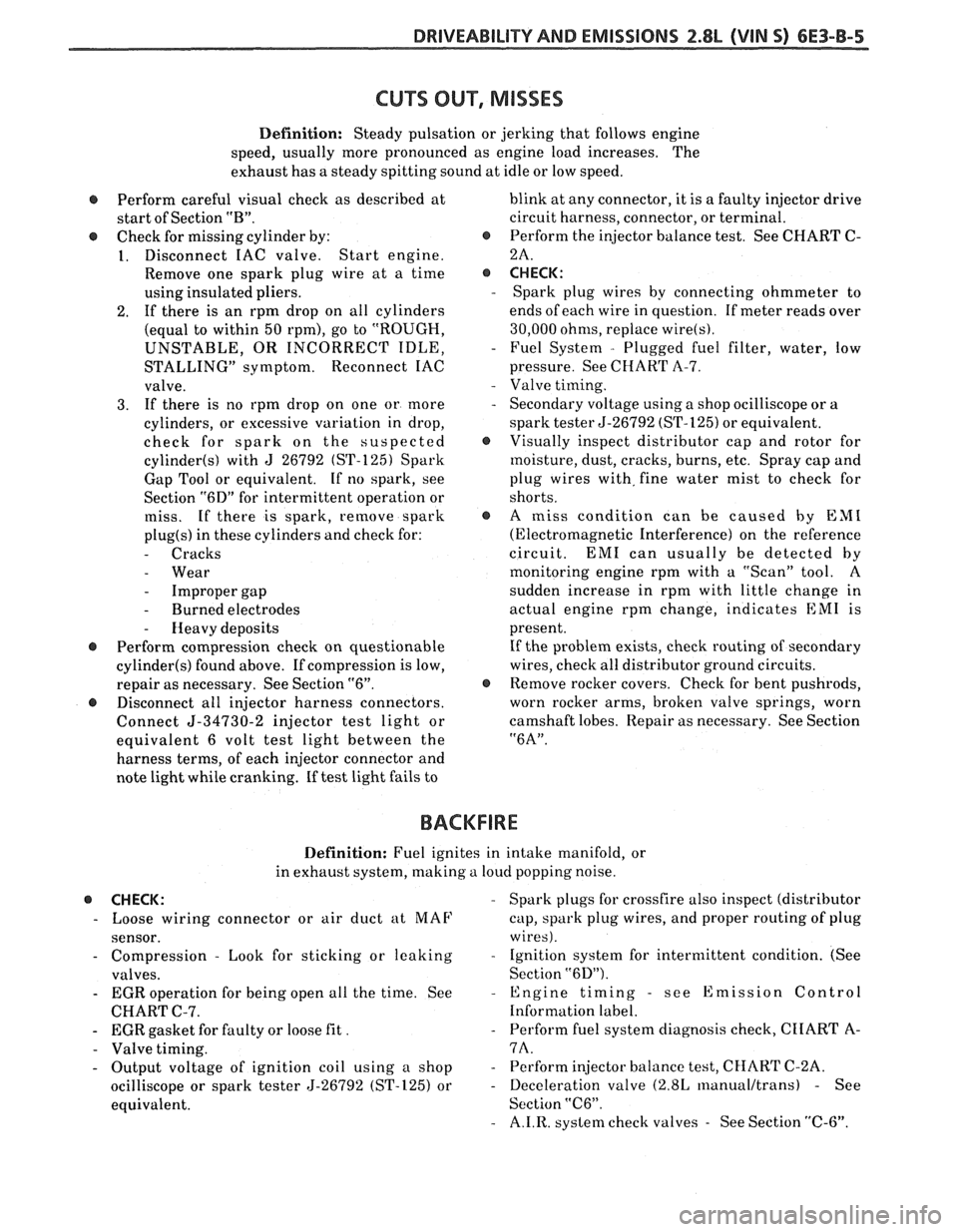
DWI\/EABILITV AND EMISSIONS 2.8L (VIN 5) 6E3-B-5
CU"T SUP, MISSES
Definition: Steady pulsation or jerking that follows engine
speed, usually more pronounced as engine load increases. The
exhaust has a steady spitting sound at idle or low speed.
@ Perform careful visual check as described at
start of Section
"B".
@ Check for missing cylinder by:
1. Disconnect IAC valve. Start engine.
Remove one spark plug wire at a time
using insulated pliers.
2. If there is an rpm drop on all cylinders
(equal to within
50 rpm), go to "ROUGH,
UNSTABLE, OR INCORRECT IDLE,
STALLING" symptom. Reconnect IAC
valve.
3. If
there is no rprn drop on one or more
cylinders, or excessive variation in drop,
check for spark on the suspected
cylinder(s) with J 26792 (ST-125) Spark
Gap Tool or equivalent.
If no spark, see
Section
"6D" for intermittent operation or
miss. If there is spark, remove spark
plug(s) in these cylinders and check for:
- Cracks
- Wear
- Improper gap
- Burned electrodes
- Iieavy deposits
@ Perform compression check on questionable
cylinder(s) found above. If compression is low,
repair as necessary. See Section
"6".
@ Disconnect all injector harness connectors.
Connect
5-34730-2 injector test light or
equivalent 6 volt test light between the
harness terms, of each injector connector and
note light while cranking. If test light fails to blink
at any connector, it is a faulty injector drive
circuit harness, connector, or terminal.
@ Perform the injector balance test. See CHART C-
2A.
s CHECK:
- Spark plug wires by connecting ohmmeter to
ends of each wire in question. If meter reads over
30,000 ohms, replace wire(s1.
- Fuel System - Plugged fuel filter, water, low
pressure. See
CHART A-7.
- Valve timing.
- Secondary voltage using a shop ocilliscope or a
spark tester 5-26792 (ST-125) or equivalent.
@ Visually inspect distributor cap and rotor for
moisture, dust, cracks, burns, etc. Spray cap and
plug wires with, fine water mist to check for
shorts.
@ A miss condition can be caused by EM1
(Electromagnetic Interference) on the reference
circuit.
EM1 can usually be detected by
monitoring engine rpm with a "Scan" tool. A
sudden increase in rpm with little change in
actual engine rpm change, indicates
EM1 is
present. If the problem exists, check routing of secondary
wires, check all distributor ground circuits.
@ Remove rocker covers. Check for bent pushrods,
worn rocker arms, broken valve springs, worn
camshaft lobes. Repair as necessary. See Section
"6A".
BACKFIRE
Definition: Fuel ignites in intake manifold, or
in exhaust system, making a loud popping noise.
CHECK:
- Loose wiring connector or air duct at MAF
sensor.
- Compression - Look for sticking or leaking
valves.
- EGR operation for being open all the time. See
CHART C-7.
- EGR gasket for faulty or loose fit .
- Valve timing.
- Output voltage of ignition coil using a shop
ocilliscope or spark tester 5-26792 (ST-125) or
equivalent.
- Spark plugs for crossfire also inspect (distributor
cap, spark plug wires, and proper routing of plug
wires).
- Ignition system for intermittent condition. (See
Section
"6D").
- Engine timing - see Emission Control
Information label.
- Perform fuel system diagnosis check, CIIART A-
7A.
- Perform injector balance test, CHART C-2A.
- Deceleration valve (2.8L ~nanualltrans) - See
Section
"C6".
- A.I.R. system check valves - See Section "C-6".
Page 715 of 1825
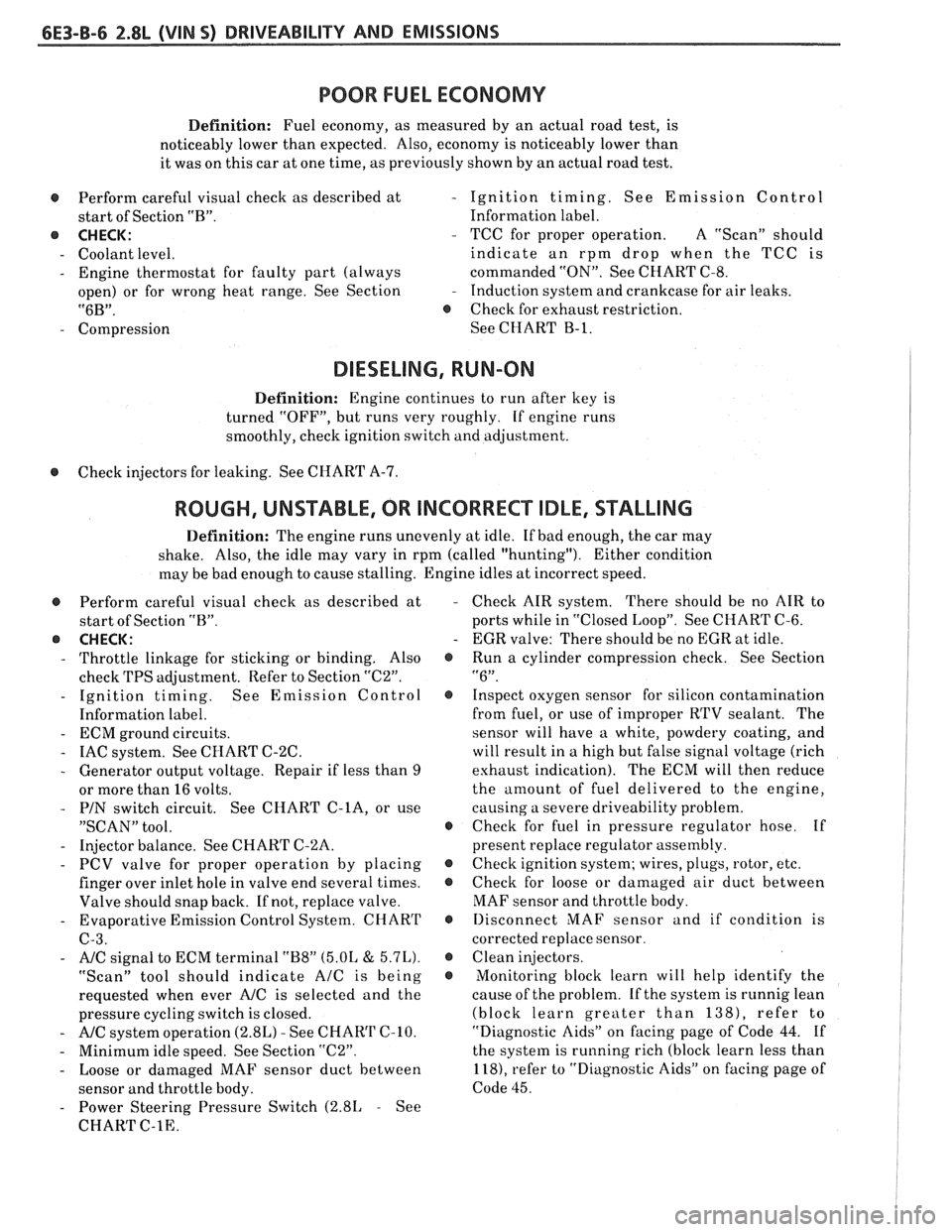
6E3-B-6 2.8L (VIN 5) DRIVEABILITY AND EMISSIONS
POOR FUEL ECONOMY
Definition: Fuel economy, as measured by an actual road test, is
noticeably lower than expected. Also, economy is noticeably lower than
it was on this car at one time, as previously shown by an actual road test.
@ Perform careful visual check as described at
start of Section "B".
8 CHECK:
- Coolant level.
- Engine thermostat for faulty part (always
open) or for wrong heat range. See Section
"6B".
- Compression
- Ignition timing. See Emission Control
Information label.
- TCC for proper operation. A "ScanJ' should
indicate an rpm drop when the TCC is
commanded "ON". See CHART C-8.
- Induction system and crankcase for air leaks.
8 Check for exhaust restriction.
See CHART
B-1.
DIESELING, RUN-ON
Definition: Engine continues to run after key is
turned "OFF", but runs very roughly. If engine runs
smoothly, check ignition switch and adjustment.
8 Check injectors for leaking. See CHART A-7.
ROUGH, UNSTABLE, OR INCORRECT IDLE, STALLING
Definition: The engine runs unevenly at idle. If bad enough, the car may
shake. Also, the idle may vary in rpm (called "hunting"). Either
condition
may be bad enough to cause stalling. Engine idles at incorrect speed.
@ Perform careful visual check as described at
start of Section "B".
@ CHECK:
- Throttle linkage for sticking or binding. Also
check TPS adjustment. Refer to Section
"C2".
- Ignition timing. See Emission Control
Information label.
- ECM ground circuits.
- IAC system. See CHART C-2C.
- Generator output voltage. Repair if less than 9
or more than 16 volts.
- PIN switch circuit. See CHART C-lA, or use
"SCAN" tool.
- Injector balance. See CHART C-'LA.
- PCV valve for proper operation by placing
finger over inlet hole in valve end several times.
Valve should snap back. If not, replace valve.
- Evaporative Emission Control System. CHART
C-3.
- A/C signal to ECM terminal "B8" (5.OL & 5.7L).
"Scan" tool should indicate AIC is being
requested when ever
A/C is selected and the
pressure cycling switch is closed.
- A/C system operation (2.8L) - See CHAR'l' (2-10.
- Minimum idle speed. See Section "C2".
- Loose or damaged MAF sensor duct between
sensor and throttle body.
- Power Steering Pressure Switch (2.81, - See
CHART
C-1E.
Check AIR system. There should be no AIR to
ports while in "Closed Loop". See CHART C-6.
EGR valve: There should be no EGR at idle.
Run a cylinder compression check. See Section
"6". Inspect oxygen sensor for silicon contamination
from fuel, or use of improper RTV sealant. The
sensor will have a white, powdery coating, and
will result in a high but false signal voltage (rich
exhaust indication). The ECM will then reduce
the
amount of fuel delivered to the engine,
causing a severe driveability problem.
Check for fuel in pressure regulator hose. If
present replace regulator assembly.
Check ignition system; wires, plugs, rotor, etc.
Check for loose or damaged air duct between
MAF sensor and throttle body.
Ilisconnect MAF sensor and if condition is
corrected replace sensor.
Clean injectors.
Monitoring block learn will help identify the
cause of the problem. If the system is runnig lean
(block learn greater than
138), refer to
"Diagnostic Aids" on facing page of Code
44. If
the system is running rich (block learn less than
118), refer to "Diagnostic Aids'' on facing page of
Code 45.
Page 716 of 1825
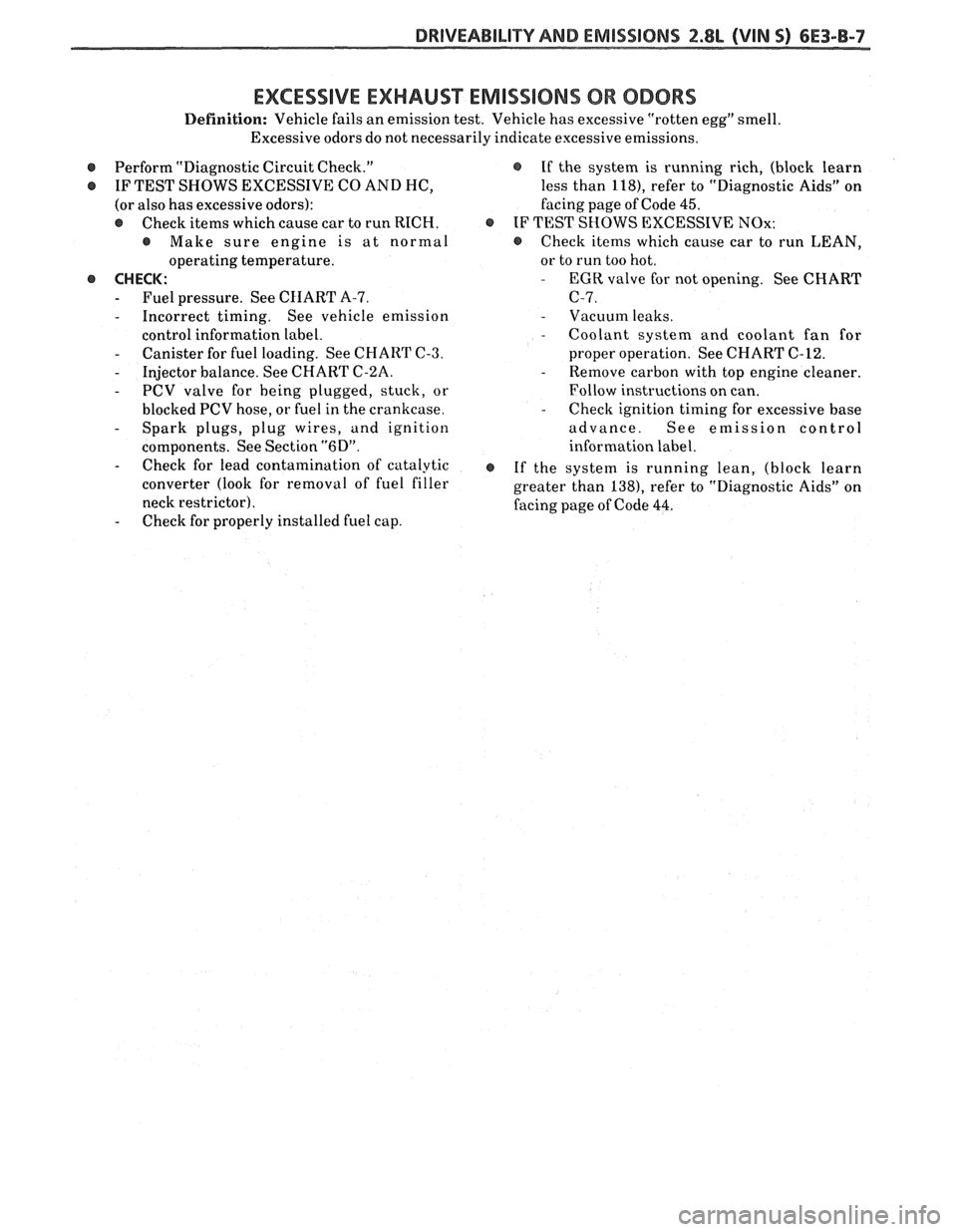
DRIVEABILITY AND EMISSIONS 2.8L (VIN S) 6E3-B-7
EXCESSIVE EXHAUST EMISSIONS 08 ODORS
Definition: Vehicle fails an emission test. Vehicle has excessive "rotten egg" smell.
Excessive odors do not necessarily indicate excessive emissions.
r Perform "Diagnostic Circuit Check."
e IF TEST SHOWS EXCESSIVE CO AND HC,
(or also has excessive odors):
@ Check items which cause car to run RICH.
@ Make sure engine is at normal
operating temperature.
@ CHECK:
- Fuel pressure. See CHART A-7.
- Incorrect timing. See vehicle emission
control information label.
- Canister for fuel loading. See CHART C-3.
- Injector balance. See CHART C-2A.
- PCV valve for being plugged, stuck, or
blocked PCV hose, or fuel in the crankcase.
- Spark plugs, plug wires, and ignition
components. See Section
"6D".
- Check for lead contamination of catalytic
converter (look for removal of fuel filler
neck restrictor).
- Check for properly installed fuel cap.
@ If the system is running rich, (block learn
less than
118), refer to "Diagnostic Aids" on
facing page of Code
45.
e IF TEST SHOWS EXCESSIVE NOx:
e Check items which cause car to run LEAN,
or to run too hot.
- EGR valve for not opening. See CHART
C-7.
- Vacuum leaks. - Coolant system and coolant fan for
proper operation. See CHART C-12.
- Remove carbon with top engine cleaner.
Follow instructions on can.
- Check ignition timing for excessive base
advance. See emission control
information label.
@ If the system is running lean, (block learn
greater than
138), refer to "Diagnostic Aids" on
facing page of Code
44.
Page 717 of 1825
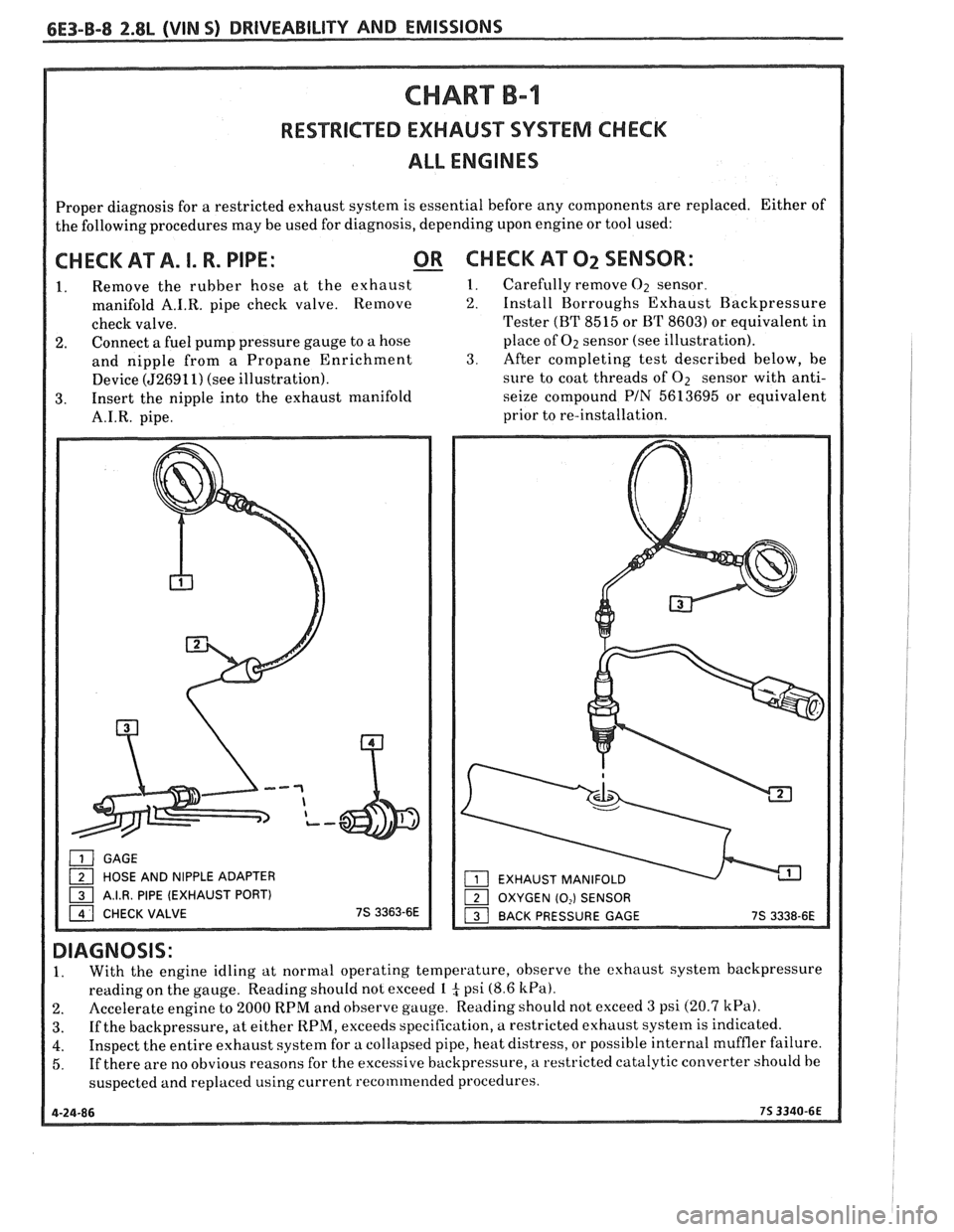
CHART B-l
RESTRICTED EXHAUST SYSEEM CHECK
ALL ENGINES
Proper diagnosis for a restricted exhaust system is essential before any components are replaced. Either of
the following procedures may be used for diagnosis, depending upon engine or tool used:
CHECK AT A. I. R. PIPE: - OR
1. Remove the rubber hose at the exhaust
manifold A.I.R. pipe check valve. Remove
check valve.
2. Connect a fuel pump pressure gauge to a hose
and nipple from a Propane Enrichment
Device (526911) (see illustration).
3. Insert the nipple into the exhaust manifold
A.I.R. pipe.
GAGE
1 HOSE AND NIPPLE ADAPTER
1 3,I.R. PIPE (EXHAUST PORT)
1 CHECK VALVE 7s 3363-6E
CHECK AT 02 SENSOR:
1. Carefully remove 02 sensor.
2. Install Borroughs Exhaust Backpressure
Tester (BT 8515 or BT 8603) or equivalent in
place of
02 sensor (see illustration).
3. After
completing test described below, be
sure to coat threads of
02 sensor with anti-
seize compound PIN 5613695 or equivalent
prior to re-installation.
DIAGNOSIS:
1. With the engine idling at normal operating temperature, observe the exhaust system backpressure
reading on the gauge. Reading should not exceed
I $ psi (8.6 kPa).
2. Accelerate engine to 2000 RPM and observe gauge. Reading should not exceed 3 psi (20.7 kPa).
3. If the backpressure, at either RPM, exceeds specification, a restricted exhaust system is indicated.
4. Inspect the entire exhaust system for a collapsed pipe, heat distress, or possible internal muffler failure.
5. If
there are no obvious reasons for the excessive backpressure,
a restricted catalytic converter should be
suspected and replaced using current
recom~nended procedures.
Page 718 of 1825
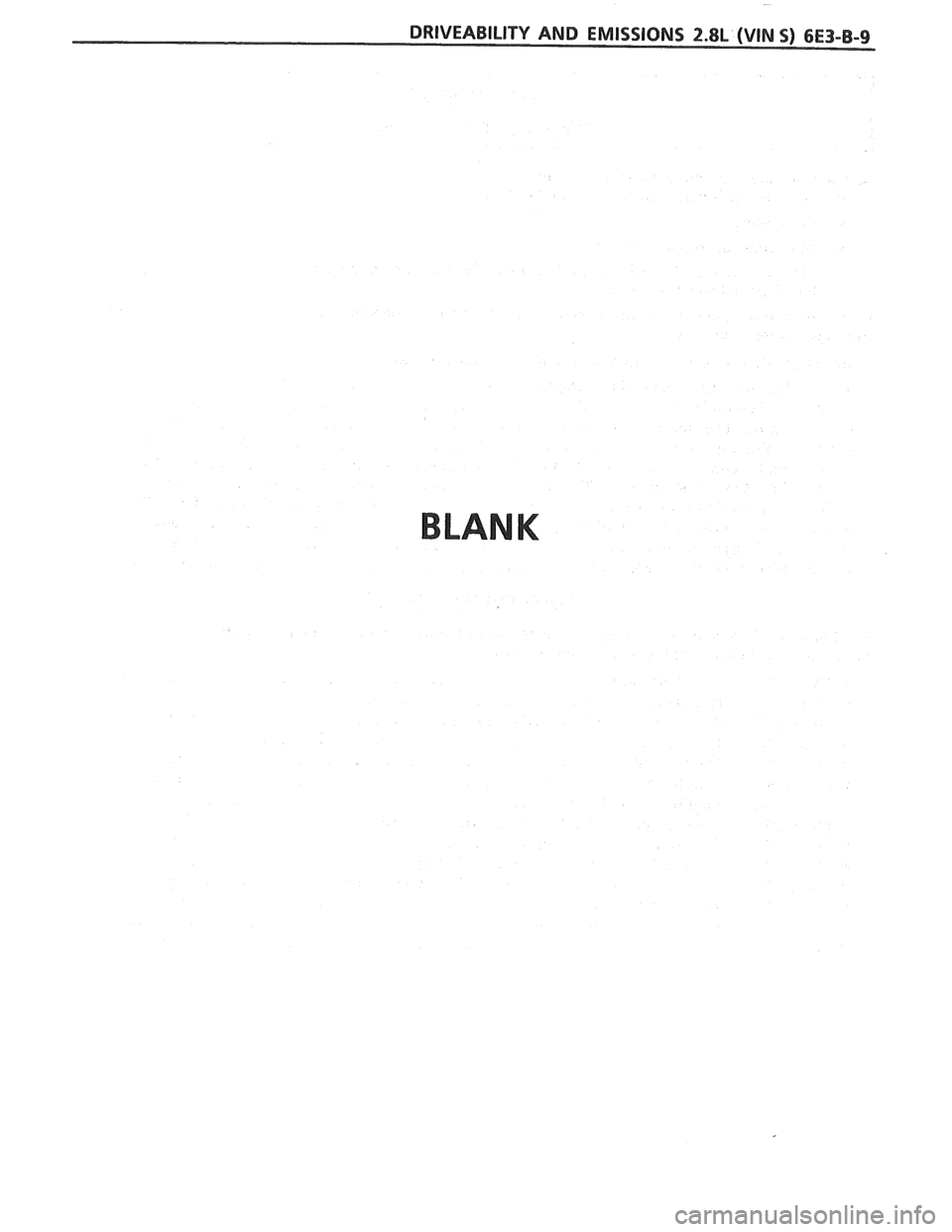
BLANK
Page 719 of 1825
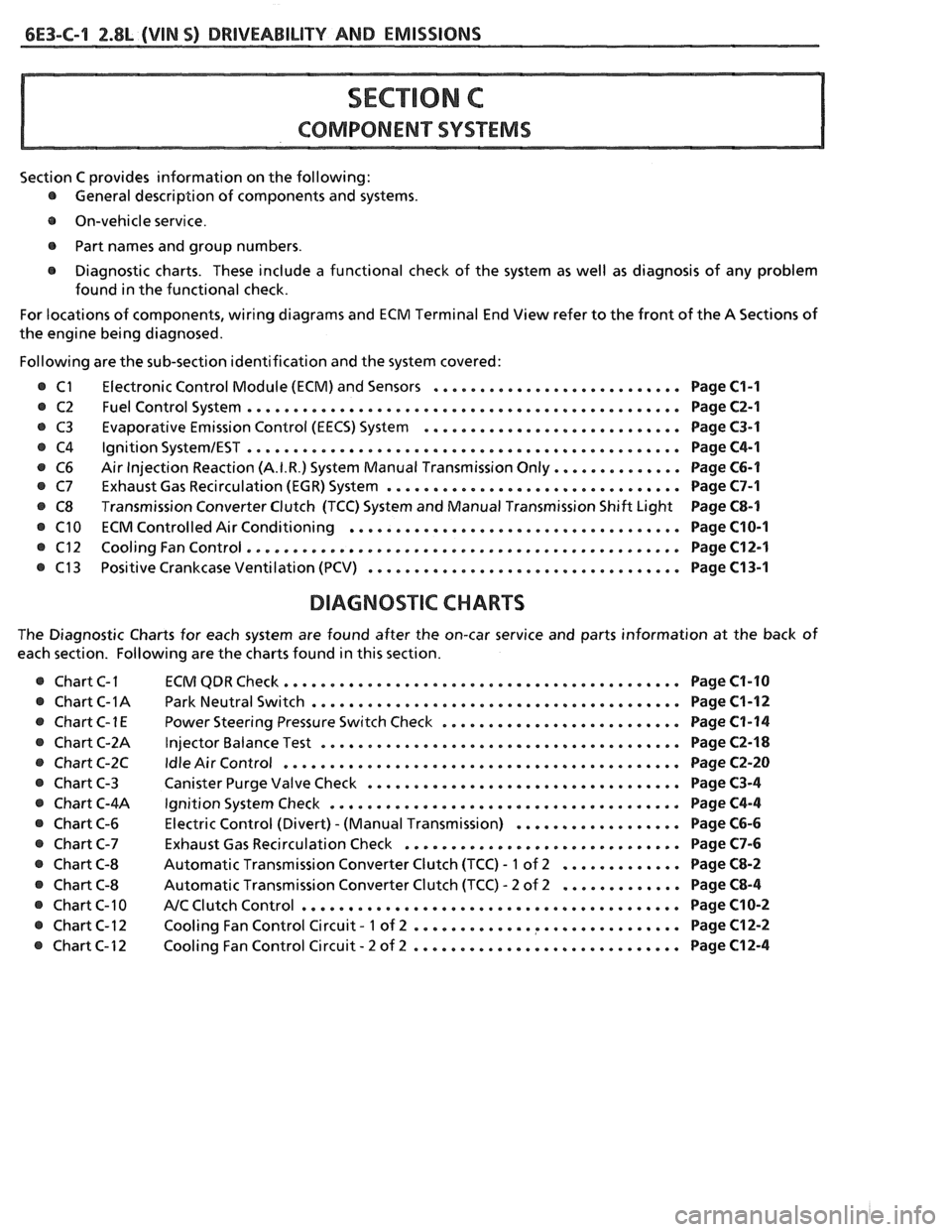
6E3-C-1 2.8L (VIN S) DRIVEABILITY AND EMISSIONS
COMPONENT SYSTEMS
Section C provides information on the following:
@ General description of components and systems .
e On-vehicle service .
@ Part names and group numbers .
@ Diagnostic charts . These include a functional check of the system as well as diagnosis of any problem
found in the functional check
.
For locations of components. wiring diagrams and ECM Terminal End View refer to the front of the A Sections of
the engine being diagnosed
.
Following are the sub-section identification and the system covered:
Electronic Control Module (ECM) and Sensors
........................... Page C1-I
Fuel Control System ............................................... Page C2-1
Evaporative Emission Control (EECS) System ............................ Page C3-1
Ignition SystemIEST ............................................... Page C4-1
Air Injection Reaction (A.I.R.) System Manual Transmission Only .............. Page C6-1
Exhaust Gas Recirculation (EGR) System ................................ Page C7-1
Transmission Converter Clutch (TCC) System and Manual Transmission Shift Light Page C8-1
ECM Controlled Air Conditioning .................................... Page C10-I
Cooling Fan Control ............................................... Page C12-1
Positive Crankcase Ventilation (PCV) .................................. Page C13-1
DIAGNOSTIC CHARTS
The Diagnostic Charts for each system are found after the on-car service and parts information at the back of
each section
. Following are the charts found in this section .
@ Chart C-I
@ Chart C-1A
e ChartC-1E
@ Chart C-2A
e Chart C-2C
@ Chart C-3
@ Chart C-4A
@ Chart C-6
@ Chart C-7
@ Chart C-8
@ Chart C-8
@ Chart C-10
@ Chart C-12
@ Chart C-12 ECM
QDR Check ........................................... Page C1-10
Park
Neutral Switch ........................................ Page C1-12
Power Steering Pressure Switch Check .......................... Page C1-14
Injector Balance Test ....................................... Page C2-18
Idle Air Control ........................................... Page C2-20
Canister Purge Valve Check .................................. Page C3-4
Ignition System Check ...................................... Page C4-4
Electric Control (Divert) . (Manual Transmission) .................. Page C6-6
Exhaust Gas Recirculation Check .............................. Page C7-6
Automatic Transmission Converter Clutch (TCC) . 1 of 2 ............. Page C8-2
Automatic Transmission Converter Clutch (TCC) . 2 of 2 ............. Page C8-4
NC Clutch Control ......................................... Page C10-2
. ............. ............... Cooling Fan Control Circuit 1 of 2 Page C12-2
. ............................. Cooling Fan Control Circuit 2 of 2 Page C12-4
Page 720 of 1825
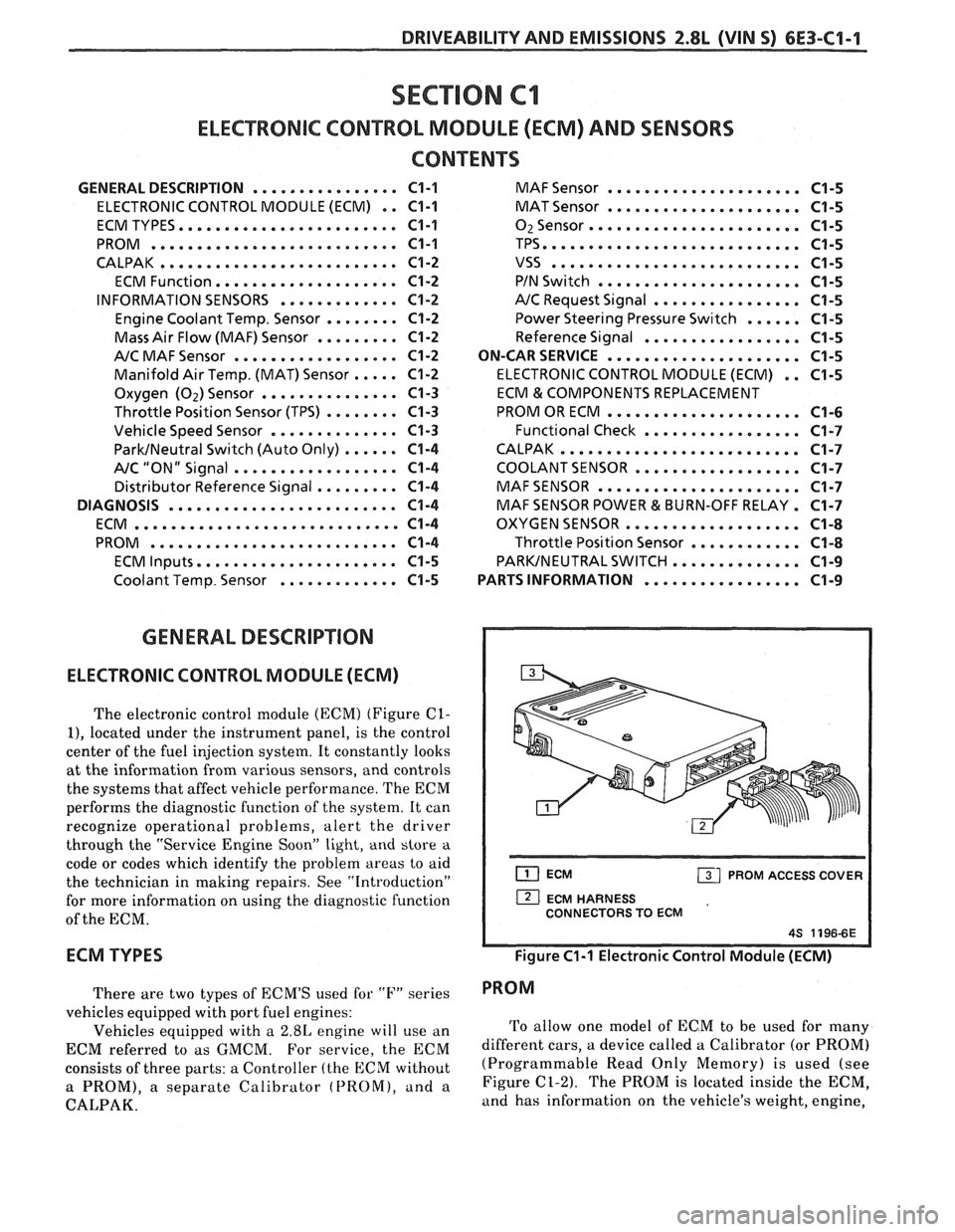
DRIVEABILITY AND EMISSIONS 2.8L WIN S) 6E3-C1-1
SECTION C1
ELECTRONIC CONTROL MODULE (ECM) AND SENSORS
CONTENTS
GENERAL DESCRIPTION ................ C1-1 MAF Sensor ..................... C1-5
ELECTRONIC CONTROL MODULE (ECM) , . C1-1 MAT Sensor ..................... C1-5
ECMTYPES.. ...................... C1-I O2 Sensor ....................... C1-5
PROM ........................... C1-1 TPS............................ C1-5
CALPAK .......................... C1-2 VSS ........................... C1-5
ECM Function..
.................. C1-2 PIN Switch ...................... C1-5
INFORMATION SENSORS ............. C1-2 A/C Request Signal ................ C1-5
........ Engine Coolant Temp. Sensor C1-2 Power Steering Pressure Switch ...... C1-5
Mass Air Flow (MAF) Sensor ......... C1-2 Reference Signal ................. C1-5
A/C MAF Sensor .................. C1-2 ON-CAR SERVICE ..................... C1-5
..... Manifold Air Temp. (MAT) Sensor C1-2 ELECTRONIC CONTROL MODULE (ECM) . . C1-5
Oxygen (Oz) Sensor ............... C1-3 ECM & COMPONENTS REPLACEMENT
........ Throttle Position Sensor (TPS) C1-3 PROMORECM ..................... C1-6
Vehicle Speed Sensor
.............. C1-3 Functional Check ................. C1-7
...... ParkINeutral Switch (Auto Only) C1-4 CALPAK.......................... C1-7
AIC "ON" Signal .................. C1-4 COOLANTSENSOR .................. C1-7
Distributor Reference Signal
......... C1-4 MAFSENSOR ...................... C1-7
DIAGNOSIS ......................... C1-4 MAF SENSOR POWER & BURN-OFF RELAY. C1-7
ECM .......e.........e........... C1-4 OXYGENSENSOR ................... C1-8
PROM ........................... C1-4 Throttle Position Sensor ............ C1-8
ECM Inputs..
.................... C1-5 PARKJNEUTRALSWITCH .............. C1-9
Coolant Temp. Sensor ............. C1-5 PARTS INFORMATION ................. C1-9
GENERAL DESCRIPTION
ELECTRONIC CONTROL MODULE (ECM)
The electronic control module (ECM) (Figure C1-
I), located under the instrument panel, is the control
center of the fuel injection system. It constantly looks
at the information from various sensors, and controls
the systems that affect vehicle performance. The ECM
performs the diagnostic function of the system. It can
recognize operational problems, alert the driver
through the "Service Engine Soon"
light, and store a
code or codes which identify the problem areas to aid
the technician in making repairs. See "Introduction"
for more information on using the diagnostic function
of the ECM.
ECM TYPES
There are two types of ECM'S used for "I?" series
vehicles equipped with port fuel engines:
Vehicles equipped with a
2.8L engine will use an
ECM referred to as GMCM. For
service, the ECM
consists of three parts: a Controller (the ECM without
a PROM), a separate Calibrator (PROM), and a
CALPAK.
ECM PROM ACCESS COVER I
1 ECM HARNESS
CONNECTORS TO ECM
Figure C1-1 Electronic Control Module (ECM)
PROM
To allow one model of ECM to be used for many
different cars, a device called a Calibrator (or PROM)
(Programmable Read Only Memory) is used (see
Figure
C1-2). The PROM is located inside the ECM,
and has information on the vehicle's weight, engine,